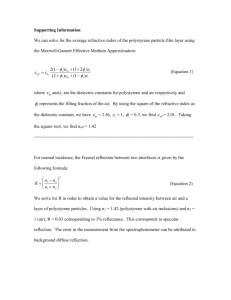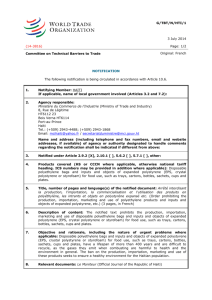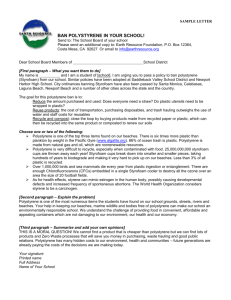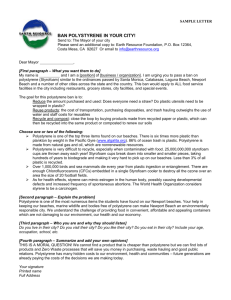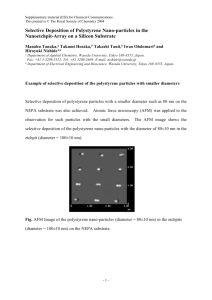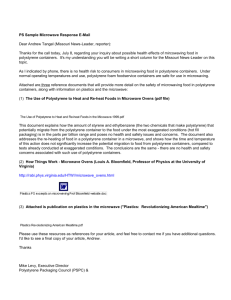Document 10283807
advertisement
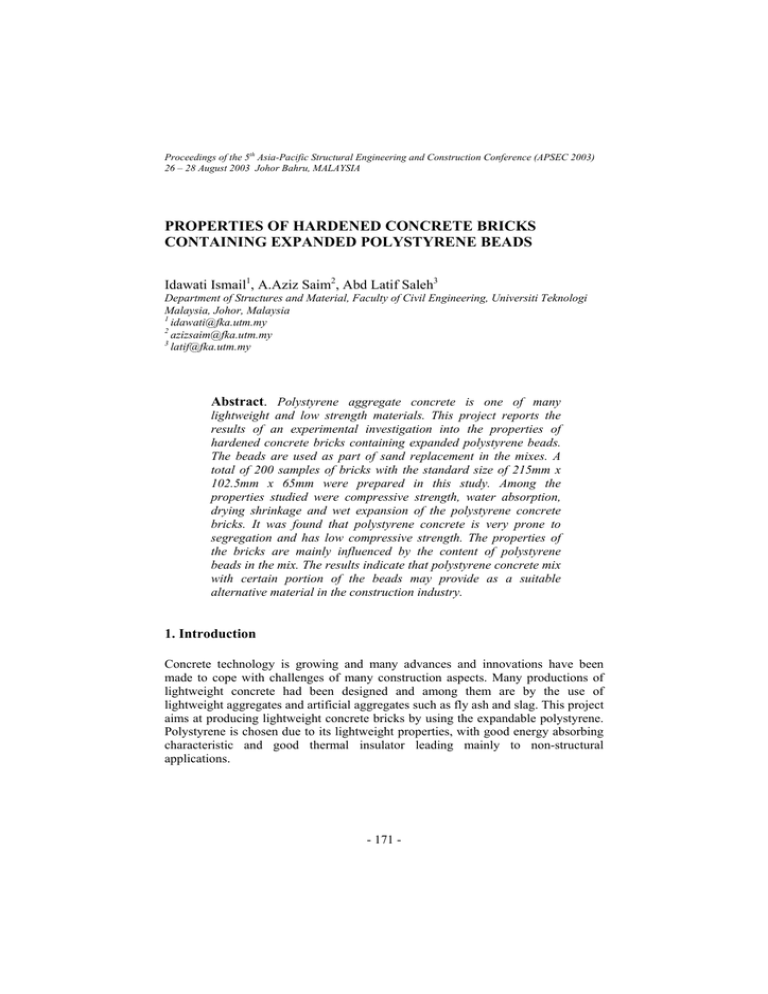
Proceedings of the 5th Asia-Pacific Structural Engineering and Construction Conference (APSEC 2003) 26 – 28 August 2003 Johor Bahru, MALAYSIA PROPERTIES OF HARDENED CONCRETE BRICKS CONTAINING EXPANDED POLYSTYRENE BEADS Idawati Ismail1, A.Aziz Saim2, Abd Latif Saleh3 Department of Structures and Material, Faculty of Civil Engineering, Universiti Teknologi Malaysia, Johor, Malaysia 1 idawati@fka.utm.my 2 azizsaim@fka.utm.my 3 latif@fka.utm.my Abstract. Polystyrene aggregate concrete is one of many lightweight and low strength materials. This project reports the results of an experimental investigation into the properties of hardened concrete bricks containing expanded polystyrene beads. The beads are used as part of sand replacement in the mixes. A total of 200 samples of bricks with the standard size of 215mm x 102.5mm x 65mm were prepared in this study. Among the properties studied were compressive strength, water absorption, drying shrinkage and wet expansion of the polystyrene concrete bricks. It was found that polystyrene concrete is very prone to segregation and has low compressive strength. The properties of the bricks are mainly influenced by the content of polystyrene beads in the mix. The results indicate that polystyrene concrete mix with certain portion of the beads may provide as a suitable alternative material in the construction industry. 1. Introduction Concrete technology is growing and many advances and innovations have been made to cope with challenges of many construction aspects. Many productions of lightweight concrete had been designed and among them are by the use of lightweight aggregates and artificial aggregates such as fly ash and slag. This project aims at producing lightweight concrete bricks by using the expandable polystyrene. Polystyrene is chosen due to its lightweight properties, with good energy absorbing characteristic and good thermal insulator leading mainly to non-structural applications. - 171 - Proceedings of the 5th Asia-Pacific Structural Engineering and Construction Conference (APSEC 2003) 26 – 28 August 2003 Johor Bahru, MALAYSIA 2. Polystyrene lightweight concrete Polystyrene is a vinyl polymer. Structurally, it is a long hydrocarbon chain, with a phenyl group attached to every other carbon atom. Polystyrene is produced by free radical vinyl polymerization, from the monomer styrene. Expandable polystyrene (EPS) meanwhile is polystyrene in raw beads being steam-heated, causing it to expand. Polystyrene has been used mainly in cold countries to make concrete blocks for residential purposes. Polystyrene aggregate concrete is one of many lightweight, low strength materials with good energy absorbing characteristics. It is well known for its good thermal and acoustic insulation properties leading mainly to non-structural applications including precast roof and wall panels and lightweight infill blocks (Parton, 1982). It has also been considered for use as a core material in sandwich panels, beams, and slabs (Parton, 1982), as a sub-base material for road pavements (Hanna, 1978) and also in floating marine structures (Bagon and Yannas, 1976). In Japan, it has been used in the construction of sea beds and sea fences (Yoshino et al., 1980) A study conducted by Perry et a.l (1991) on mix details and material behavior of polystyrene aggregate concrete proved that strength and density are controlled by varying mix proportions. Ravindrarajah et al. (1993) reported their study on the properties of hardened concrete containing polystyrene beads. Their results showed that the strength, stiffness and chemical resistance of polystyrene aggregate concrete of a constant density are affected by the water to cement ratio. Another study by Bischoff et al. (1991) found that polystyrene aggregate concrete is useful to absorb energy and to reduce contact loading loads during hard impact at low velocities. Work was also carried out by the Cement and Concrete Association of New Zealand in 1991 which examined the strengths and some drying shrinkages of recycled EPS concrete. The study highlighted difficulties in compaction and finishing of concrete with densities below 1000kg/m3. Hamdan (2000) in a study reports that the use of polystyrene beads as lightweight aggregates shows lightweight property that highlights the use of polystyrene aggregate concrete in non-structural applications. 3. Experimental works 3.1 Materials The materials used in this study were ordinary Portland cement, fine sand, polystyrene beads (2.36mm) supplied by BASF (Malaysia) and tap water. - 172 - Proceedings of the 5th Asia-Pacific Structural Engineering and Construction Conference (APSEC 2003) 26 – 28 August 2003 Johor Bahru, MALAYSIA 3.2 Casting and mixing Five different specimens of concrete bricks were prepared, tagged as PC, and P1 to P4. These specimens differ from one another by the polystyrene beads content in their mixes. Because the beads are very light in weight and density, the mixes were prepared by volume. The control mix, specimen PC has proportion of 1:3:0 which stands for 1 part cement, 3 parts sand and 0 part polystyrene. Polystyrene was added in proportions as part of sand replacement as shown in Table 1. The specimen with most polystyrene content is specimen P4, which consists of 1 part cement, 1 part sand and 2 parts polystyrene. The water-cement ratio is 0.4 for all specimens. Mix proportions/ Ratios 1:3:0 1:2.5:0.5 1:2:1 1:1.5:1.5 1:1:2 Table 1 Specimens and mix proportions Percentage of sand replacement (%) 0 16.7 33.3 50.0 66.7 Specimens PC P1 P2 P3 P4 3.2.1 Method of casting The beads have the tendency to float to the top surface during mixing and compaction, therefore the dry sand and cement were first added together in a typical pan mixer before water was added in. After sufficient mixing, the polystyrene beads were added and thoroughly mixed into the mortar. To minimize segregation, vibration compaction was avoided and all the mixes were compacted by hand tamping. The specimens were air-dried as the curing method. 3.3 Laboratory tests The tests included in this project were the dimension, weight and density test, compressive strength at 7 and 28 days age, ultrasonic pulse velocity, water absorption drying shrinkage and wet expansion. All test procedures were done according to BS 6073:1981 as a part of testing for brick standards, and BS 1881:1986 part 202-203 for ultrasonic pulse velocity. 4. Results and analysis 4.1 Dimension By referring to BS 6073:1981 as a part of testing for brick standards, the dimensions for each mix of the concrete bricks were evaluated. The result is shown in Table 2. - 173 - Proceedings of the 5th Asia-Pacific Structural Engineering and Construction Conference (APSEC 2003) 26 – 28 August 2003 Johor Bahru, MALAYSIA Specimen PC P1 P2 P3 P4 Table 2 Measurements taken for each mix Mix ratio Length (mm) Width (mm) 1:3:0 1:2.5:0.5 1:2:1 1:1.5:1.5 1:1:2 5178.8 5186.9 5180.3 5182.3 5177.5 2491.6 2505.9 2479.2 2505.8 2485.7 Thickness (mm) 1616.6 1623.8 1609.5 1614.7 1625.1 By comparing these results from each mix to the given standard, it is shown that the dimensions of the mixes conforming to the standard. The main reason to the differences in the dimensions of each specimen is in the molds that were used in preparing the bricks. It seems that wooden molds need to be changed as expansion and contraction to wet and dry conditions of the mixing process and the surrounding weather affect moulds size. Bleeding is also suspected to contribute to the different sizes of the dimensions of the specimens. Bleeding that occurred to the specimens may resulted from the presence of large voids contributed by the beads in the specimens. This results in the loss of water in the specimens. 4.2 Weight and density Weight and density is the first indicator whether the material can be considered into the lightweight material category. Average weight and density in each mix can be shown in Fig.1. Mix P2, P3 and P4 have density less than the recommended density for lightweight concrete which is 1800 kg/m3. It is found that there is a direct relationship between the polystyrene content and the weight and density of the specimens. The lightweight property of polystyrene beads contributes to the low weight and low density of the specimens. - 174 - Proceedings of the 5th Asia-Pacific Structural Engineering and Construction Conference (APSEC 2003) 26 – 28 August 2003 Johor Bahru, MALAYSIA density (kg/m3) 4.5 4 3.5 3 2.5 2 1.5 2500 1 0.5 0 500 2000 1500 1000 density (kg/m3) weight (kg) weight (kg) 0 1:3:0 (PC) 1:2.5:0.5 (P1) 1:2:1 (P2) 1:1.5:1.5 (P3) 1:1:2 (P4) Polystyrene mix ratios Figure1 Relationship between weight and density with polystyrene mix ratios 4.3 Compressive strength In this study, 7-day and 28-day compressive strength tests were carried out. It was observed that there is a relationship between the compressive strength and the weight and density of the specimens. Compressive strength test at 7-day and 28-day shows similar manner in the decrease in strength with respect to polystyrene contents. Table 3 below summarizes the compressive strength of each mix at 7-day and 28-day. Specimen PC P1 P2 P3 P4 Table 3 7-day and 28-day compressive strength Mix ratio 7-day 28-day 28-day percentage compressive compressive reduction in strength (N/mm2) strength (N/mm2) strength (%) 1:3:0 1:2.5:0.5 1:2:1 1:1.5:1.5 1:1:2 16.3 14.8 13.8 5.3 4.3 19.0 15.3 14.0 6.8 5.1 - 175 - 0 19.5 8.5 51.4 25.0 Proceedings of the 5th Asia-Pacific Structural Engineering and Construction Conference (APSEC 2003) 26 – 28 August 2003 Johor Bahru, MALAYSIA As polystyrene beads contribute to low weight and low density, it also contributes to the low strength of the specimens. Polystyrene beads do not contribute to the strength of the material. The strength obtained in the mixes with polystyrene beads is very low, due to the beads’ weakness in compression. This is also because polystyrene beads do not react chemically with the mix to contribute strength. There is a reduction in strength as polystyrene content is increased. 4.4 Ultrasonic pulse velocity Ultrasonic pulse velocity is used in this study as an estimation of specimens' strength and correlated as an exponential curve. Concrete with lightweight aggregate is likely to give a lower pulse velocity at a given strength level. For every mix with different 28-day compressive strength, the relationship with respect to pulse velocity is found as fc = 3.81e0.34V with correlation coefficient of 0.92 as shown in Fig 2. 25 fc = 3.81e0.34V R2 = 0.92 2 Compressive strength (N/mm ) 20 15 10 5 0 2.81 (P4) 3.66 (P3) 3.51 (P2) 3.56 (P1) 4.14 (PC) Pulse velocity (km/s) Figure 2 Relationship between pulse velocity and 28-day compressive strength 4.5 Water absorption Experimental investigation on specimens’ capacity to absorb water was done using the 5-hour boiling method. It was observed as in Fig. 3 below that specimen with more polystyrene content show greater absorption capacity. The water absorbed in the bricks due to the water migrates outwards into the capillary pores in the hardened cement paste. The absorption of water into the bricks is not because polystyrene adsorbs water; in fact, polystyrene has a closed-cell structure that - 176 - Proceedings of the 5th Asia-Pacific Structural Engineering and Construction Conference (APSEC 2003) 26 – 28 August 2003 Johor Bahru, MALAYSIA forbids absorption of water into it. However, the presence of polystyrene which induces pores and voids to the bricks had enhanced the water migration in the bricks. Therefore, the absorption of water is higher for mix that has more polystyrene content. 20 18 Percentage of absorbtion (%) 16 14 12 10 8 6 4 2 0 1:3:0 (PC) 1:2.5:0.5 (P1) 1:2:1 (P2) 1:1.5:1.5 (P3) 1:1:2 (P4) Polystyrene mix ratios Figure 3 Relationship between percentage of water absorption and polystyrene content 4.6 Drying shrinkage and wet expansion Drying shrinkage and wet expansion tests aim to ensure the capacity of bricks when exposed to the hot and cold weather of the environment. Concrete loses moisture as it hardens, causing it to contract or shrink. Figure 4 shows that specimens with more polystyrene beads experience more percentage of shrinkage with 0.133% for specimen P4 and 0.058% for specimen P1. Lower amount of cement results lower hydration and reaction between cement, sand and water. Excess water in the specimens with more polystyrene beads will expose to higher percentage of shrinkage. The content of polystyrene beads also affects the wet expansion percentage as shown in Fig. 5. It shows that specimen P4 had experience highest wet expansion of 0.163% and P1 with lowest percentage for 0.069%. Specimens with higher content of polystyrene have more voids and pores, attracting more water to gain into it. - 177 - Proceedings of the 5th Asia-Pacific Structural Engineering and Construction Conference (APSEC 2003) 26 – 28 August 2003 Johor Bahru, MALAYSIA 0.14 Percentage of shrinkage (%) 0.12 0.1 0.08 0.06 0.04 0.02 0 1:3:0 (PC) 1:2.5:0.5 (P1) 1:2:1 (P2) 1:1.5:1.5 (P3) 1:1:2 (P4) Polystyrene mix ratios Figure 4 Relationship between percentage of shrinkage and polystyrene content 0.18 0.16 0.14 0.12 0.1 0.08 0.06 0.04 0.02 0 1:3:0 (PC) 1:2.5:0.5 (P1) 1:2:1 (P2) 1:1.5:1.5 (P3) 1:1:2 (P4) Polystyrene mix rat ios Figure 5 Relationship between percentage of wet expansion and polystyrene content - 178 - Proceedings of the 5th Asia-Pacific Structural Engineering and Construction Conference (APSEC 2003) 26 – 28 August 2003 Johor Bahru, MALAYSIA 5. Conclusion The workability characteristics of the mixes are very different from the normal concrete. Compaction by rodding or vibration was not effective owing to the lightweight nature of the mixes. The mixes were cohesive that the cement slurry coating the beads was very effective in holding the mix together. Polystyrene concrete brick is very prone to segregation where placing and compacting can be quite difficult using vibratory compaction techniques. Polystyrene concrete bricks with densities less that 1800 kg/m3 have very low strength. Mix P2 with compressive strength of 14.0 N/mm2 and density of 1646 kg/m3 is the most suitable mix to be used as a load bearing internal wall. Mix P3 and P4 can be used as a non-load bearing internal wall. Properties of polystyrene concrete bricks found through this study indicate its potential to be used in the construction industry. References [1] Bischoff P.H et al., ‘Polystyrene Aggregate Concrete Subjected to Hard Impact’, Proceedings-Institution of Civil Engineers, Part 2: Research and Theory, Vol. 89, 1990, pp. 225-239. [2] Bungey J.H et al., Testing of Concrete in Structures, Chapman and Hall, UK, 1996 [3] Hamdan.A., Kajian Rekabentuk Campuran Konkrit menggunakan Styropor sebagai Agregat Ringan, Universiti Teknologi Malaysia, 2000 [4] Jackson N et al., Civil Engineering Materials, Macmillan, UK, 1988 [5] Neville A.M., Properties of Concrete, Longman, UK, 1995 [6] Park S.G et al., ‘Report Study-Polystyrene Aggregate Concrete’, Building Research Association of New Zealand, 1999 [7] Parton G.M et al., ‘Polystyrene Bead Concrete Properties and Mix Design’, Magazine of Concrete Research, Vol. 43, No. 3, 1982, pp. 153-161 [8] Perry S.H et al., ‘Mix Details and Material Behavior of Polystyrene Aggregate Concrete’, Magazine of Concrete Research, Vol. 43, No. 154, 1991, pp. 71-76 [9] Ravindrarajah et al., ‘Properties of Hardened Concrete Containing Treated Expanded Polystyrene Beads’, Cement and Concrete Composites, Vol. 16, No. 4, 1993, pp. 273-277 [10] Riley M.A., ‘Mix Details and Material Behavior of Polystyrene Aggregate Concrete’, Magazine of Concrete Research, Vol. 43, No. 155, 1991, pp. 87-92 - 179 -
